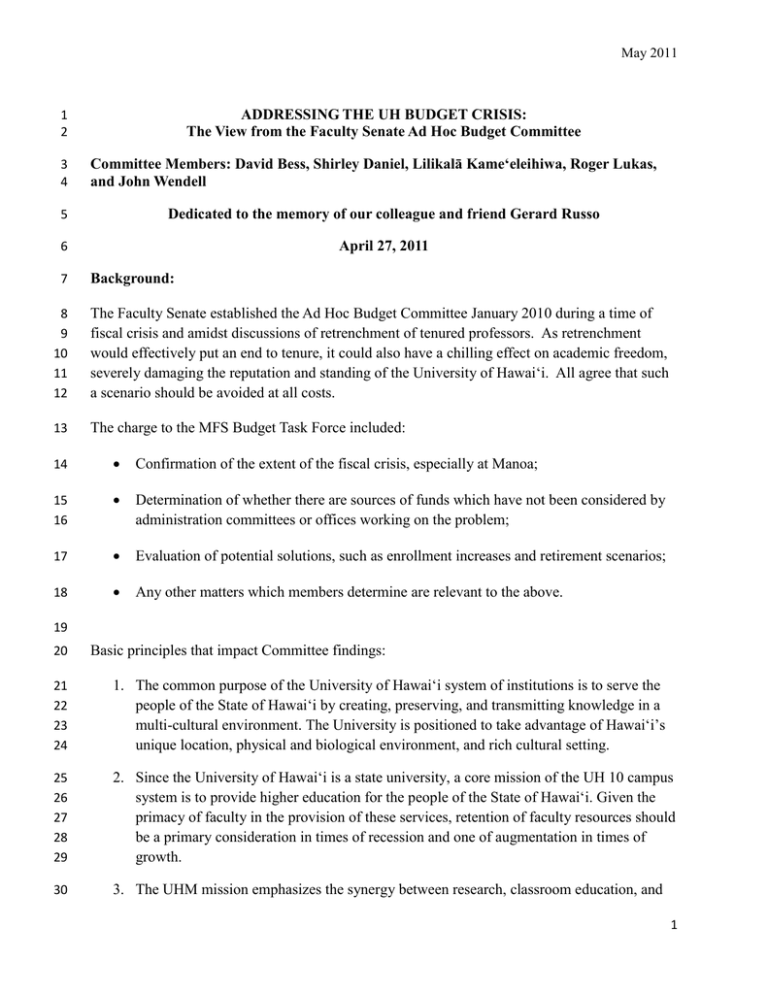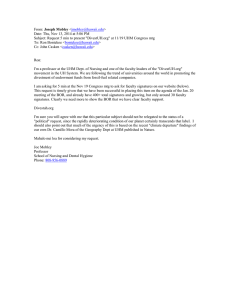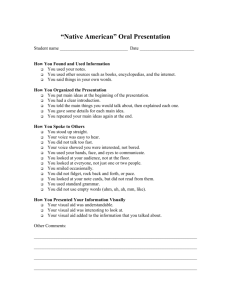ADDRESSING THE UH BUDGET CRISIS:
advertisement

May 2011 1 2 3 4 ADDRESSING THE UH BUDGET CRISIS: The View from the Faculty Senate Ad Hoc Budget Committee Committee Members: David Bess, Shirley Daniel, Lilikalā Kameʻeleihiwa, Roger Lukas, and John Wendell 5 Dedicated to the memory of our colleague and friend Gerard Russo 6 April 27, 2011 7 Background: 8 9 10 11 12 The Faculty Senate established the Ad Hoc Budget Committee January 2010 during a time of fiscal crisis and amidst discussions of retrenchment of tenured professors. As retrenchment would effectively put an end to tenure, it could also have a chilling effect on academic freedom, severely damaging the reputation and standing of the University of Hawaiʻi. All agree that such a scenario should be avoided at all costs. 13 The charge to the MFS Budget Task Force included: 14 Confirmation of the extent of the fiscal crisis, especially at Manoa; 15 16 Determination of whether there are sources of funds which have not been considered by administration committees or offices working on the problem; 17 Evaluation of potential solutions, such as enrollment increases and retirement scenarios; 18 Any other matters which members determine are relevant to the above. 19 20 Basic principles that impact Committee findings: 21 22 23 24 1. The common purpose of the University of Hawai‘i system of institutions is to serve the people of the State of Hawaiʻi by creating, preserving, and transmitting knowledge in a multi-cultural environment. The University is positioned to take advantage of Hawai‘i’s unique location, physical and biological environment, and rich cultural setting. 25 26 27 28 29 2. Since the University of Hawaiʻi is a state university, a core mission of the UH 10 campus system is to provide higher education for the people of the State of Hawaiʻi. Given the primacy of faculty in the provision of these services, retention of faculty resources should be a primary consideration in times of recession and one of augmentation in times of growth. 30 3. The UHM mission emphasizes the synergy between research, classroom education, and 1 May 2011 31 32 33 service activities. Manoa plays a unique role in delivering an integrated education to future generations, providing important services to the community, and supporting economically important activities in the State of Hawaii. 34 35 4. The strategic plans, including appropriate prioritizations, of the University and Manoa should be the driving forces for budget decisions. 36 37 5. The provision of quality services to our students should drive our utilization of public funds, and such decisions should be made as efficiently as possible. 38 39 6. The budgeting process should be open and transparent both within the System as well as within Manoa and involve stakeholders such as the faculty. 40 41 42 7. The Committee believes that University/Manoa systems should encourage entrepreneurial activities, which both enhance the academic programs and serve as increased revenue streams from outside sources. (Dealing with revenues.) 43 44 FACTS: 45 FINDINGS SYSTEMWIDE: 46 47 48 49 50 51 52 53 54 55 56 57 1. While the State fiscal crisis is real and significant, the University of Hawaiʻi 6.30.2010 financial statements reveal it is in good fiscal health as indicated by two key financial ratios. The primary reserve ratio, total expendable net assets divided by total expenses, is 45% and the current ratio, current assets divided by current liabilities, is 1.89. According to national University budget analysts Howard Bunsis and Rudy Fichtenbaum, this primary reserve ratio is "quite healthy" and the current ratio is "very solid. "The university administration in the Management Discussion and Analysis portion of the 6.30.2010 financial statements is optimistic stating "Looking toward the future, despite the challenges presented by the current state and national economies, management believes that the University is well-positioned to maintain its strong financial condition and level of excellence in service to students, the research community, and the State of Hawai‘i." 58 59 Furthermore, financial rating services Standard and Poors, Moody's, and Fitch continue to rate UH Bonds very highly with ratings of A+, Aa3 and AA- respectively. 60 61 62 63 2. In FY08-09, State of Hawaiʻi funding for UH was about 51% of the total budget [$732.5 M out of $1,443.5 M; in FY10-11, UH received cuts of 13.4% (FY10) and 13.7% (FY11) of its State funding [$98 M and $100 M out of 732.5 M]. Most of the State contributions to the UH budget are for personnel (faculty, staff and administration salaries and fringe 2 May 2011 64 65 benefits) and facilities (construction, maintenance and utilities). [Source: UH FY08-09 System Reports to the BOR]. 66 67 68 69 3. 70 71 72 4. With a total of 209 Administrators, there is now 1 administrator for every 17 faculty [1:17], which is higher than the faculty: student ratio on most campuses. Moreover, most administrators make double the amount of the average salary paid to professors. 73 74 75 76 77 5. Since the decision was made to appoint a Chancellor for UHM, and separate out UHM from the UH System administration, the greatest administrative growth has been at the System level [41 FTE at $8.8M per year] and at Manoa [26 FTE at $5.4 M] per year. The new UHM administration costs were added on top of the already existing and well working system of deans and dean’s staff [64 FTE at $16.8 M per year]. 78 79 80 81 6. Following the creation of the UHM Chancellor position, a decision was made in 2001 to make every campus provost a chancellor; each then increased their staff, producing an apparant overlap in function between System and individual campuses and greatly increasing administrative costs. 82 83 84 85 86 7. The most efficient administrative model is that of the Community Colleges where there is one Vice President for Community Colleges in charge of 7 campuses, and where on average there is one administrator for every 33 faculty [1:33]. At Kapiʻolani CC that teaches the largest number of students [9,102] out of all the Community Colleges, the administrative to faculty ratio is 1:72. 87 88 89 90 91 8. At the four-year campuses of UHM, UHH, and UHWO, the average administrative to faculty ratio is 1:16, as opposed to the 1:33 average ratio for most community colleges, or the 1:77 ratio at Kapiʻolani Community College, suggesting that the four year campuses may be over-administered in comparison to the community colleges. It is unclear whether the difference is justified by mission or size difference between the two groups. 92 93 94 95 9. Providing necessary teaching faculty on another four-year campus at West-Oʻahu, 20 miles away from the flagship campus of UH Manoa, will cost an estimated $59M per year in salaries. The cost of administrative FTE would be in addition to the cost of faculty FTE. 96 97 10. The UH System controls revenue generating properties not being fully utilized at their greatest potential. For example, although there are 12 observatories on Mauna Kea, lease In the past ten years, there has been a rapid growth in administration costs, both system wide and on each campus, so that now with 209 administrators, administration costs alone are $44 M per year [fringes included]. [Source: UHPA Webpage. <http://www.uhpa.org/salary-research/uh-executive-managerial-salaries>] 3 May 2011 98 99 100 101 102 103 rental for the use of the “most important astronomical mountain in the world” is only $1 per year. However, while UHM astronomers do receive “free” use of those observatories, there does not appear to be a cost-benefit analysis as to the actual cost for such “free” use in comparison to the fees paid by other researchers for the use of the telescopes. Depending on how much non-UH professors pay, UH may find that it would be cheaper to collect a lease rental and pay for our own UH astronomy faculty to have viewing time. 104 105 106 RECOMMENDATIONS FOR IMPROVED BUDGET EFFICIENCIES AT THE UH SYSTEM LEVEL: 107 108 109 1. As previously indicated the University's financial condition remains healthy and in fact the primary reserve ratio and current ratio both improved from 6.30.2009 to 6.30.2010 (39% to 45% and 1.68 to 1.89 respectively) in spite of the cuts to the general fund. 110 111 112 113 114 115 116 117 2. The University remains financially vulnerable if the Governor and Legislature resort to draconian cuts to the General Fund allocation or sweeps and fails to restore the University's revolving funds. If the University of Hawaiʻi is forced to accept draconian cuts then administrators should be retrenched before faculty are retrenched. Those with return rights should be able to join departments at salaries commensurate with other faculty in the unit. Since it is faculty who teach the students who pay tuition and it the faculty who bring in the grant money, faculty retention should have higher priority than retention of administration. 118 119 3. An audit should be conducted to ascertain redundancies and inefficiencies in the overlap between the UH System administration and UHM administration. 120 121 122 123 124 125 4. In order to be more efficient in use of administration personnel, central administrative functions of the four year colleges could come under one Vice President for Four Year Campuses, [just as all of the Community Colleges are under one vice president] at no net administrative cost. While the size and complexity of Manoa, Hilo, and an independant UHWO may justify individual Chancellors, it is unclear whether Chancellors for each community college can be justified. 126 127 128 129 130 5. UHWO should be developed as an integral part of UHM, just as is the Kakaʻako campus. Current UHWO professors should be integrated with sister departments at UHM, and all relevant UHM departments should have teaching at West Oʻahu included in their work loads. Since the BA programs are inextricably linked to MA and PhD programs, students at West-Oʻahu would benefit from integrated academic programs. 4 May 2011 131 132 133 6. Once the new buildings are constructed at UHWO, unutilized space should be made available to UHM research programs that currently are in distress from lack of space. This would help realize higher RTRF rates. 134 135 7. Across the system there are opportunities to reduce expensive electricity bills via capital improvements. This should be considered as a top priority. 136 137 138 139 140 141 142 143 8. An audit should be conducted of all income realized by Mauna Kea Observatories with a commensurate increase in lease rental be required for all new observatories being suggested [as well as the new one for Haleakalā]. Existing leases should also be vetted and renegotiated. Since both Mauna Kea and Haleakalā are considered sacred mountains to Native Hawaiians, Pūko’a Council has suggested a desecration tax of $40 M per observatory. In addition the University should seek to identify other properties with income producing potential that can be realized without compromising the University's teaching and research endeavors. 144 145 FACTS 146 FINDINGS UH MĀNOA: 147 148 1. State of Hawaiʻi funding for UHM (FY08-09) was 29% [$264 M] of the total UHM budget [$908 M] 149 150 151 152 153 154 2. UHM received State funding cuts of 24% [$63.6 M] and 25% [$66 M] out of the $264 M total state funding for UHM. While it seemed as though- the budget crisis at UHM was severe, salaries and other operating costs were met through a 4 % cut from UHM operating budgets, and in anticipation of further loss of funding. When the anticipated cuts did not materialize, a portion of the $8 M reserve surplus was redistributed to UHM schools in January 2011. 155 156 157 3. While the old UHM strategic plan (2002) was out of date, and never provided programmatic or budgetary priorities or guidance, the new UHM Strategic Plan, just finished in January 2011 has proposed such guidance for budget priorities 158 159 160 4. Currently there is a general lack of understanding as to why certain budget decisions were made and on what basis. There has been no visible tie to strategic plans in many instances. This has created an environment of mistrust among faculty. 161 162 163 5. The apparent processes/decisions for the System and Manoa administrations to “capture” funds from units’ entrepreneurial activities tend to stifle entrepreneurial activities exactly at a time when they ought to be encouraged. 5 May 2011 164 165 166 167 168 RECOMMENDATIONS FOR IMPROVED BUDGET EFFICIENCIES AT THE UH MĀNOA LEVEL: 169 170 171 172 173 1. The faculty of UH Manoa should always be closely involved with developing new strategic plans [as occurred with the most recent UHM 2011 Strategic Plan] which should prioritize activities and drive budget decisions, so that the decisions do not have an ad hoc appearance. These plans need to set priorities for growth which then help clarify priorities for reductions. 174 175 176 177 2. All budget decisions should be more transparent from the chancellor down to deans and department heads, so that stakeholders can understand the basis on which decisions are made. The University brings in funds in numerous categories, and some means of providing an overall picture of all funds should be devised. 178 179 180 3. Mechanisms to increase faculty understanding of budget processes, such as further trainings, or an audit of the various funds should be undertaken by the Faculty Senate to increase the foundations for transparency. 181 182 183 4. Entrepreneurial activities should be encouraged and supported to generate increased revenues for units, Manoa, and the University. Such activities could include , but are not limited to: 184 185 a. Provide incentives for units/individuals for the provision of increased educational opportunities, such as distance education. 186 187 b. Increase transparency in the costs and benefits of teaching, research, and public service). 188 189 190 c. Reconsider ethics “standards” to permit appropriate collaborations with the commercial sector. (Can also help to build the economy.) This could include feefor-service consultation/collaboration. 191 d. Consider enhanced lease/rental fees for UHM facilities. 192 193 e. The Regents could increase the tuition for International and out-of-state students and then increase marketing efforts. 6 May 2011 194 195 f. Better utilization of teaching spaces and increasing them as demand dictates, thus realizing greater enrollment. 196 197 g. Along with tuition increases, support for students (e.g. scholarships, computers, etc.) should be increased. 198 199 CONCLUSION: 200 201 202 203 The Committee has found that there are significant areas for improvement in the University budgeting processes, and there are numerous ways to reduce costs without reducing services, many of which could be done in fairly short order. Some of these are at the University System level, and some at the Manoa level. 204 205 206 First, there needs to be transparency in both process and budget driven by a true strategic plan with realistic budgets. The implementation proposal in the current 2011-2015 Manoa strategic plan should help facilitate this change in practice. 207 208 209 Second, there should be an external review by university consultants of management systems with a view to redundancy in administrative functions between System and the individual campuses, including UHM. 210 211 212 Third, the planning for the administration and staffing of UH West Oahu should recognize the value of UHM faculty and administrative expertise and avoid future inefficiencies from duplication between the two campuses. 213 214 Fourth, there needs to be policy and cultural change to encourage increased entrepreneurial activity, as it is in the best interests of units and their stakeholders and the university as a whole. 215 216 Fifth, the faculty should be looked upon as a resource and should be actively involved in these improvement activities. 217 218 219 Finally, whenever fiscal crises in the State of Hawai’i creates a critical reduction in support of UH operations, the UH BOR should look first to reducing administrative costs before compromising faculty resources. 220 221 222 223 7

